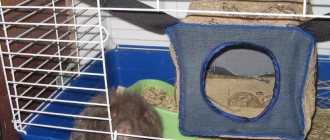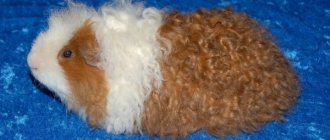- home
- Guinea pig
- Guinea pig health
02/11/2019 The health of the pet is the main concern of the owner. This article explains what guinea pigs suffer from, how to recognize the disease, and what to do to cure your beloved animal.
How to tell if your guinea pig is sick
The animal is cheerful and active, happily eating, drinking, playing and communicating with its owner or other animals. But if a guinea pig gets sick, then you need to pay attention to this and observe the animal.
Symptoms that indicate your pet is unwell.
- Lethargic, depressed behavior. The pig does not eat, hides, refuses to communicate, prefers solitude for several days in a row;
- refusal of food;
- the coat has become dull, partial baldness, wounds;
- an enlarged eyeball or, conversely, the eyes are barely visible, the appearance of tears and pus from the eyes;
- heavy breathing, sneezing, discharge from the nasal passages, crusting on the face;
- sneezing, coughing, deep chest cough, the animal wheezes or whistles;
- dry, hard excrement or, conversely, liquid diarrhea with a strong unpleasant odor, constipation;
- change in skin tone on the ears and inside, swelling or inflammation of the skin of the ears, the appearance of black discharge from the ears;
- skin itching, scratching, restlessness of the animal;
- heterogeneity of urine, darkening of urine, blood in urine;
- problems with movement, loss of coordination, slow movement, seizures and immobility;
- painful sensations in the process of eating food, the animal cannot swallow food, so it falls out of the mouth with a lot of saliva;
- persistent skin lesions on the paws;
- neoplasms.
Any of these symptoms indicate that your pet is sick. Some symptoms require observation, while others require urgent intervention. In any case, you should not self-medicate. Treatment of guinea pigs is best left to professionals.
Baldness - alopecia
Baldness can occur both in individual areas of the body and cover large areas, most often as a result of stress, for example, when maintenance rules are violated.
Another cause of alopecia is animals eating their own fur. This behavior is associated with improper feeding and can be corrected by normalizing the diet.
A characteristic sign of skin diseases is itching - the guinea pig itches, may fall over on its side, and its convulsive movements are similar to an epileptic attack.
Infectious diseases of guinea pigs
The animal picks up the infection from sick relatives, from other pets or from blood-sucking insects. Such diseases are difficult to tolerate and often the animal dies. Some of the infectious diseases of little pigs are diseases that can be transmitted to humans. Here are some diseases and symptoms that will help you understand the level of danger of the disease.
Plague
The disease is dangerous for weakened, young and old animals, ending in death within a short period of time. To understand that your guinea pig is sick, you need to observe your pet. At the first time of infection, the pet becomes depressed and lethargic. Subsequently, convulsions, disorientation, uncontrolled movements and paralysis appear. If symptoms occur, the animal must be shown to a specialist. Confirmation of the diagnosis means that the animal must be euthanized.
Mycoplasmosis
The disease is caused by damage to the upper respiratory tract, the development of pathogenic microflora, which leads to pneumonia. The disease affects individuals with weakened immune systems: the elderly, young and weakened.
The disease is transmitted during contact of a healthy individual with a sick animal.
Signs of the disease:
- Refusal of food and water;
- lethargy;
- eyes fester, coughing, sneezing, pus from the nose;
- labored breathing;
- elevated body temperature.
Mycoplasmosis develops quickly. In the absence of appropriate treatment, the animal dies within 3–5 days. At the first symptoms, the animal must be shown to a veterinarian. For mycoplasmosis, antibiotics, immune and anti-inflammatory drugs, and expectorant suspensions are prescribed.
Rabies is transmitted when a healthy animal is bitten by a sick animal infected with the virus. The first symptoms of the disease: apathy, lethargy, refusal to eat, followed by sudden attacks of severe agitation. Next, the animal falls into an aggressive state, in which it is able to bite everyone who is in contact with it. Rabies is contagious to guinea pigs, other animals and humans. The disease develops within 10 days, after which the sick animal dies.
At the slightest suspicion of rabies infection, the animal must be taken to a veterinary clinic, where tests will be taken to confirm the diagnosis. If the diagnosis is confirmed, the animal is immediately euthanized.
Lymphocytic choriomeningitis is an infectious disease transmitted from a sick animal to a healthy one not only through physical contact, but also through common objects, such as a feeder or drinking bowl. This disease is also dangerous for people. If an animal develops sudden apathy, lethargy, loss of appetite, elevated body temperature, vomiting, fear of light and convulsions, it is necessary to urgently contact a specialist to determine an accurate diagnosis. As with rabies, confirmation of lymphocytic choriomeningitis leads to immediate euthanasia of the animal. It is also necessary to check other pets for the disease. To prevent choriomeningitis, pigs need to be vaccinated.
Diseases of choriomeningitis and rabies are diseases of guinea pigs that are dangerous to humans.
Parasitic diseases of guinea pigs
Sarcoptic mange is a skin disease caused by subcutaneous mites that settle in the germ layer of an animal's skin. Ticks move from the skin of a sick animal to a healthy individual and gnaw a passage into the epigium layer. The process of gnawing through the upper layers of the epithelium gives the pig a lot of unpleasant sensations: itching, restlessness, and the formation of growths. When diagnosing sarcoptic mange, the animal is prescribed appropriate medications. Confirmation of the diagnosis occurs after scrapings are taken and tested in the laboratory.
Trixacarosis is an infection with the Trixacarosis cawi mite. This parasite causes itching by its actions, which drives animals crazy. The animals stop eating, drinking, and scratch their bites until they are wounded. Prolonged course of the disease causes a decrease in immunity, which leads to miscarriages and disorientation. If left untreated, the animal dies from a lack of fluid in the body or from an infection that the weakened body is unable to overcome.
Confirmation of the diagnosis occurs as a result of laboratory analysis of scrapings. Medicines are prescribed by a specialist.
Fleas, lice and lice are parasites that cause no less concern than ticks. Their bites cause irritation, the animal itches and becomes restless. These parasites are dangerous to other pets and humans. The parasites themselves and their nits can be seen with the naked eye in the animal’s fur and on its body. Treatment is carried out with special drugs prescribed by a doctor.
Worms. All domestic animals are susceptible to infection with worms. Helminth eggs enter the body through water, food and on the paws of pets that are walked outside. Symptoms of infection are: refusal to eat, eating disorders, weight loss, lethargy.
To treat helminthic infestation, the animal is prescribed anthelmintic drugs.
Non-communicable diseases of guinea pigs
Pasteurellosis is an inflammation of the mucous membrane of the upper respiratory tract as a result of a cold or when harmful microbes enter, causing the formation of pus. The pet develops snot and purulent discharge, sneezing, refusal to feed, and lethargy. If pasteurellosis is not treated at an early stage, it progresses to bronchitis and pneumonia.
Treatment includes a set of procedures for clearing the nasal passages, anti-inflammatory and immune medications and vitamins.
Pneumonia occurs in cases of advanced rhinitis or when the pet is hypothermic. Symptoms include: pus in the nasal passages, fever, cough, wheezing and whistling when breathing.
If a guinea pig gets pneumonia, treatment requires a complex of drugs aimed at eliminating inflammation, maintaining immunity, eliminating phlegm from the lungs and maintaining vitality.
Bloating is a painful eating disorder. Since pigs cannot cope with the gases accumulated in the intestines on their own, they need help. If your pet is left unattended in this condition, it can die from pain and digestive problems.
Symptoms of bloating are: lethargy and apathy, refusal to eat, heavy breathing, greatly enlarged abdominal cavity.
Treatment of bloating begins with carminatives and tummy massage. Soreness is suppressed with painkillers. To normalize the microflora, the pet is put on a diet with the addition of prebiotics.
Constipation in pigs is dangerous due to rupture of the animal's intestinal wall. Which in turn leads to death. Constipation is caused by a lack of succulent foods and water in a pet’s diet, overfeeding with dry food, and diseases of the digestive tract.
Symptoms of constipation are: lack of bowel movements, refusal to eat, vomiting, pain on palpation of the abdomen.
Constipation is treated with Vaseline oil, which is injected into the pet's anus. Laxatives are given orally. After relief of the condition, a restorative diet with the addition of probiotics is necessary.
Skin diseases of guinea pigs: dermatitis, baldness, can be caused by an unhealthy psychological environment for the pet, fungi and allergies. If pathologies are detected on the skin, you should seek help from a veterinarian.
Guinea pigs also suffer from diabetes and obesity. In the case of diabetes mellitus, the animal has an increased need for water, cloudy corneas, swelling, and a decrease in the amount of urine. This disease must be treated only as prescribed by a veterinarian.
Obesity is characterized by weight gain and shortness of breath, as well as dandruff. This disease develops from systematic overeating and lack of exercise. In case of mild obesity, it is possible to cure a guinea pig at home. It is necessary to put the pig on a light diet and give it the opportunity to run, climb and jump. In advanced cases, you need to contact a veterinarian.
Urolithiasis in pigs develops as a result of poor nutrition, obesity, and physical inactivity. The animal refuses to eat, squeaks when trying to pee, the urine becomes darker and there may be drops of blood in it. Treatment of this disease can be with medication if the size of the stones is small. If dissolving the stones is impossible, then surgical intervention is prescribed.
Guinea pig cancer develops due to genetic mutations. From the age of 5 years, pigs are susceptible to developing cancer. Detection of the disease in the early stages makes it possible to achieve a complete cure. You can distinguish a neoplasm on the surface of the skin by regularly examining your pet. Internal changes cannot be detected in the early stages.
Mechanical wounds
Tissue damage in pigs is treated with antiseptic treatment.
Before starting treatment, you need to clean the wound from dirt and hair and rinse the tissue.
To wash wounds, it is better to use a solution of potassium permanganate , in a ratio of 1:1000.
Or you can use a 3% hydrogen peroxide solution .
After drying, the wound is lubricated with disinfectant ointment . Prednisolone or streptocidal ointment are suitable as such an ointment.
The wound is treated daily. Instead of ointment, you can use a bandage with streptocide .
In addition to these diseases, guinea pigs often have:
- conjunctivitis;
- ectoparasites , which negatively affect the condition of the animal’s fur and skin;
- parasites - they are destroyers of internal organs - salmonellosis, tympany, trichomoniasis, fascioliasis, cystitis;
- Otitis externa - the ear canal becomes inflamed.
If you become ill, take your guinea pig to a veterinarian immediately.
Before visiting the doctor, sketch out your animal’s “hospital chart”:
- year and place of purchase of the pig;
- conditions of detention (cage, room temperature, humidity, what is included in the diet, mineral supplements and vitamins);
- the period of appearance of the first signs of the disease;
- previous mumps diseases.










